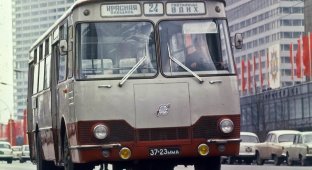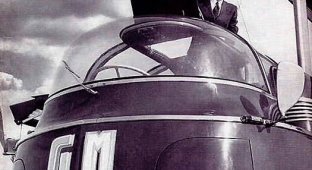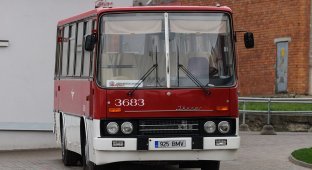Yesterday there was a post about American buses, and today I suggest reading about Soviet buses. Let's look at the most famous and interesting buses produced before the mid-80s.

So, the history of Soviet buses began with a bus based on the AMO F-15.
The first AMO bus with a capacity of 14 passengers was created in 1926 on the chassis of a 1.5-ton AMO-F-15 truck. The body was made on a frame made of bent wooden profiles and sheathed in metal, the roof was covered with leatherette. There was only one passenger door - in front of the rear wheel arch. Four-cylinder carburetor engine producing 35 hp. allowed the bus to accelerate to 50 km/h. In addition, since 1927, a two-door postal bus (the back door was behind the rear wheel arch) and an ambulance (without side doors) were produced. Third-party manufacturers also installed their own bodies on the AMO-F-15 chassis, for example, an open one with a canvas awning for servicing resorts. Photo from a 1983 postcard:

Later, an extended version appears - AMO 4 (1933). 22 places. Maximum speed with 6-cylinder engine 60 hp. was 55 km/h. A batch of several dozen cars was produced.

Based on the ZIS-5, or rather its lengthened base from 3.81 to 4.42 m, the ZIS-11 chassis in 1934-1936. A 22-seater (total number of seats 29) bus ZIS-8 was produced. Six-cylinder in-line carburetor engine with a volume of 5.55 liters and a power of 73 hp. allowed the ZIS-8 with a total weight of 6.1 tons to accelerate to 60 km/h. Only 547 units were produced at ZIS. ZIS-8.

In 1938, the ZiS-8 was replaced on the assembly line by the more advanced ZiS-16, which met the trends of that time. Production of the ZIS-16 bus, which, in accordance with the then automotive fashion, had a streamlined body shape, but was still built on a wooden frame, began in 1938 and continued until August 1941. The bus could accommodate up to 34 passengers (with 26 seats). Boosted to 84 hp the ZIS-16 engine accelerated the vehicle with a total weight of 7.13 tons to 65 km/h.

The production of passenger buses was resumed after the war, in 1946.
Then a body was developed, which simultaneously became the MTV-82 tram, the MTB-82 trolleybus and the ZiS-154 bus. The ZiS-154 was not just a bus... In 1946, domestic designers managed to create a hybrid!
The design of this bus was advanced for the domestic automobile industry: the first domestic serial all-metal load-bearing car-type body (by the way, unified with the MTB-82 trolleybus and the MTV-82 tram) with a passenger door in the front overhang and an engine in the rear of the body, a pneumatic door drive, adjustable in three directions: driver's seat, diesel and electric transmission with electric generator and electric motor. Forced diesel YaAZ-204D with a power of 112 hp. allowed a bus with a gross weight of 12.34 tons to accelerate to 65 km/h. A total of 1,164 ZIS-154 buses were produced. However, diesel, which was just being mastered in production at that time, turned out to be undeveloped in terms of exhaust smoke and reliability, so the ZIS-154 equipped with it, which also suffered from a whole bunch of “childhood diseases,” became the object of serious complaints from citizens and operators, which led to the relatively quick removal of the bus from service. production in 1950. One of them is preserved in the Mosgortrans museum.

The replacement for the unsuccessful ZIS-154 was the easier to manufacture, but less capacious 8-meter ZIS-155, whose design used elements of the ZIS-154 body and units of the ZIS-150 truck. By the way, it was on the ZIS-155 that an alternating current generator was introduced for the first time in the domestic automobile industry. The bus could carry 50 passengers (28 seats). Engine ZIS-124 with a power of 90 hp. accelerated a car with a total weight of 9.9 tons to 70 km/h. A total of 21,741 ZIS-155 buses were produced, which remained the main model of bus fleets in the capital and other large cities of the USSR from the mid-50s to the mid-60s.
Preserved in the Mosgortrans museum, as well as as monuments in some cities and sheds in some collective farms.

In 1955, for the first time in the USSR, an intercity bus was developed (before that, ZiS-155 cars ran along the Moscow - Yalta route, it’s scary to imagine how long and how it was like to travel in it..) The result was a huge, luxurious bus in the American style.
 The bus with an original monocoque body 10.22 m long could carry 32 passengers, seated in comfortable aircraft seats type with headrests and variable backrest tilt. The power plant consisted of
The bus with an original monocoque body 10.22 m long could carry 32 passengers, seated in comfortable aircraft seats type with headrests and variable backrest tilt. The power plant consisted of
a YAZ-206D two-stroke diesel engine, located transversely with the gearbox at the rear of the bus and driving the rear axle with a cardan shaft located at an angle to the longitudinal axis of the bus. In terms of the level of exterior and interior design, passenger comfort and dynamic qualities, the ZIS(ZIL)-127 corresponded to the best foreign analogues and deservedly was the flagship of the domestic automotive industry. However, the overall width of the ZIS-127 was too large, equal to 2.68 m, which exceeded international requirements (vehicle width no more than 2.5 m) and the emphasis on the development of economic relations with socialist countries, members of the CMEA, which were given priority in the production of large-class buses ( Hungary, Czechoslovakia) decided the fate of a completely competitive model (in fact, the last competitive domestic bus) - in 1960, production of the ZIL-127 was curtailed. Total in 1955-1960. 851 ZIS(ZIL)-127 buses were produced.
To this day, the ZiS-127 has been preserved in perfect condition in a museum in Tallinn. There are also several cars throughout the territory of the former USSR that are in “barn in the backyard of a motor depot” condition.
It is interesting that on the basis of the ZIL-127 in 1959, NAMI created and tested the Turbo-NAMI-053 gas turbine bus, which reached a speed of 160 km/h or more. The gas turbine engine mounted in the rear of the cabin developed 350 hp. and was half the weight of the base YaMZ-206D diesel engine. However, such a machine did not go into production due to the complexity of production and operation.

ZIL-158, ZIL-158V - city bus. It was produced from 1957 to 1959 by ZIL and from 1959 to 1970 by LiAZ. ZIL-158 was the main bus model in the city bus fleets of the Soviet Union in the 60s and early 70s of the XX century. It was a further modernization of the ZIS-155 bus. It was distinguished by a body lengthened by 770 mm with an increased capacity of up to 60 people. nominal passenger capacity (32 seats), redesigned front and rear masks, modified side windows, and an engine with 9% more power. The first ZIL-158 had windows in the ventilation hatches in the roof, as well as windows in the corners on the rear roof slopes.
A front-engine layout was used, which later migrated to the LiAZ-677 and PAZ-652.
Sometimes such buses still appear...
 At the same time, bus production began in Lviv, at a plant that had previously produced truck cranes and trailers .
At the same time, bus production began in Lviv, at a plant that had previously produced truck cranes and trailers .
LAZ-695. I think he needs no introduction... Initially he looked like this. Huge windows in the ceiling (the one on the far side, the earlier one, is tinted), and an interesting air intake on the rear roof. Rear-engine layout, ZiLovsky engine. It began production back in 1956, and since then it has been simplified and transformed many times.

There were quite a few changes to the chassis during the entire production period.

And in the end, 695 turned into such a native and familiar worker of commuter routes, which was produced right up to 2002 (and in fact - until 2010!!!).

At the end of the 50s, LAZ began developing intercity buses. There were dozens of interesting options, but only a few went into series. For example, LAZ-697

In 1961, the LAZ - Ukraine bus was created. Think "Queen of the Gas Station." Learned?
 In 1967, a bus was created that made a real world breakthrough.
In 1967, a bus was created that made a real world breakthrough.
In the spring of 1967, this bus took part in the international bus competition in Nice (XVIII International Bus Week), where it received the following awards:
- Prize of the President of France, two Grand Prizes of Distinction and a Special Prize of the Organizing Committee - for participation in the rally.
- Silver medal for bodybuilders - for the bodywork competition.
- Grand Prize and Organizing Committee Cup - for technical tests.
- Big Cup - for absolute first place in driving skill (driver - test engineer S. Borim).
Here it is, "Ukraine-67"

Let's return to LiAZ, which in 1962 began producing the legend. LiAZ-677. Warm, gurgling and swaying to an incredible amplitude, it is familiar to almost everyone and needs no introduction. In some places they still run, but in most cities they have long been melted down “into pots”.

There were many options for execution. for example for the far north.
 Meanwhile, Ukravtobusprom engineers have prepared a surprise.
Meanwhile, Ukravtobusprom engineers have prepared a surprise.
1970 The WORLD'S first low-floor bus. LAZ-360. Two copies collected. The first one is LAZ360EM. In 1970, when creating the LAZ-360EM (in some sources LAZ-360E), the main
The designers' goal was to lower the floor level in the bus to 360mm above road level (hence the bus index - "360"). It was possible to make the bus low-floor only by abandoning cardan transmissions, so the transmission on the LAZ-360EM is electromechanical. The bus engine (170 hp/132 kW) together with an electric generator was located in the front (most likely behind the driver’s seat), and the driving wheels were rear, connected to traction electric motors. A special feature of the bus was a four-axle chassis with small-diameter tires. Two front axles are steered, two rear axles are driven. The body with an unusual artistic design was also interesting - windshields curved in a vertical plane and trapezoidal side windows. The length of the bus was 11,000mm.

Some time later, it became clear that the chosen four-bridge scheme with an electric transmission did not justify itself, and then the design of the bus was thoroughly revised and practically developed anew. For the updated version, a two-axle design was chosen, with the usual mechanical transmission, but with front driven and steered wheels - thus making it possible to make a flat, low floor along almost the entire length of the bus. The engine of the new bus also changed its position in the cabin - now it was on the right side of the driver. The number and location of entrance doors have also changed. The modernized bus was named LAZ-360 (that is, with a low floor level, but without an electromechanical transmission).

There were other developments that did not go into series. For example, LAZ-696 1966-1968. The first bus in the USSR with a modern and still generally accepted layout. Developments based on it were used to create LiAZ-5256, LAZ-5252 and a dozen other buses of the late 80s.

In 1973, the Ukraine-73 bus was created. The floor level of the passenger compartment was slightly raised relative to the driver's cabin, which is why the bus became one and a half stories tall (a now generally accepted layout). In addition to all the options of 1971, the Ukraine-73 offered passengers an automatically opening entrance door (the doors opened outward, moving in different directions) and air conditioning. It was planned that the engine on the bus would be a diesel YaMZ-740 (a prototype of a diesel engine for KAMAZ), but the bus did not get this engine, so it was necessary to install a ZIL-375YA5.

Well, in the 80s they finally started installing diesel engines on buses. for example, LAZ-4202 received a KamAZ-640 engine. The first cars came with the Lviv-3 GMP, but quite quickly the design was adapted for the suburbs - model 42021 already received a manual transmission, and the pure city 4202 with GMP remained a rare bird.

LiAZ-5256..

City, intercity... they completely forgot about the “City-Rural” connection. Traditionally, buses of this group were created according to the principle “take a GAZ-51 (or 53) truck and put on a bus body.”
Good old PAZ-652 (1958-1968).

PAZ-672 (1968-1989)

PAZ-3205 (1979, 1984, and serially - from 1989 to this day)

And also all kinds of KAVZs

Conclusion - there were dozens of ideas and innovative ideas. We have something to be proud of; our developments have kept pace with the times, and sometimes significantly ahead of them. But alas, what was produced was cheaper and simpler, and outdated buses were produced for decades without any serious modernization.
























